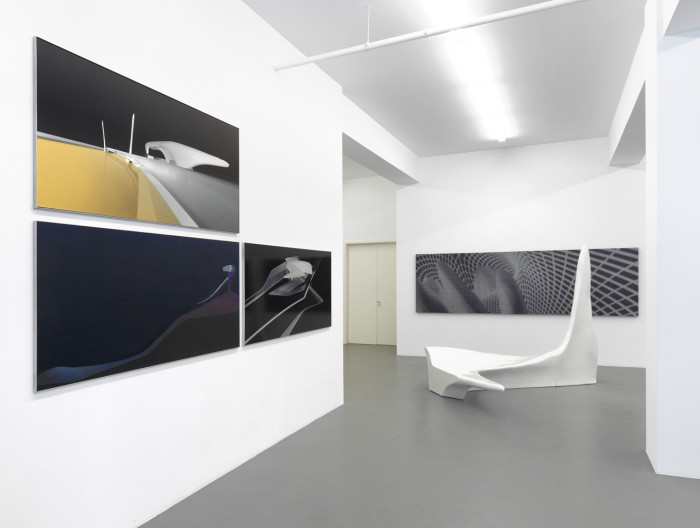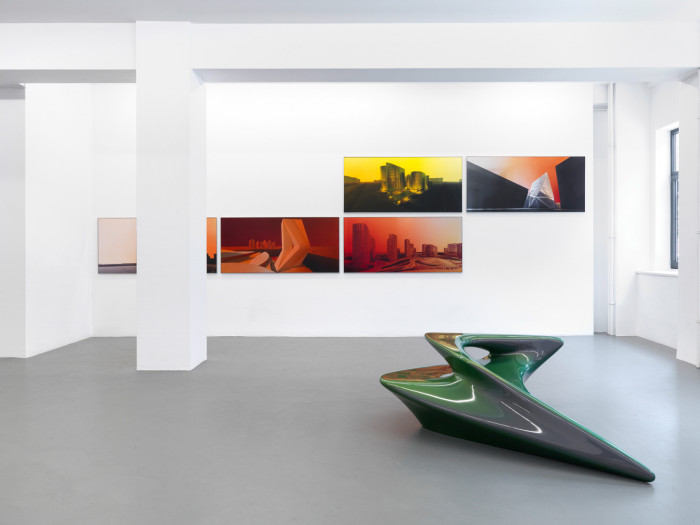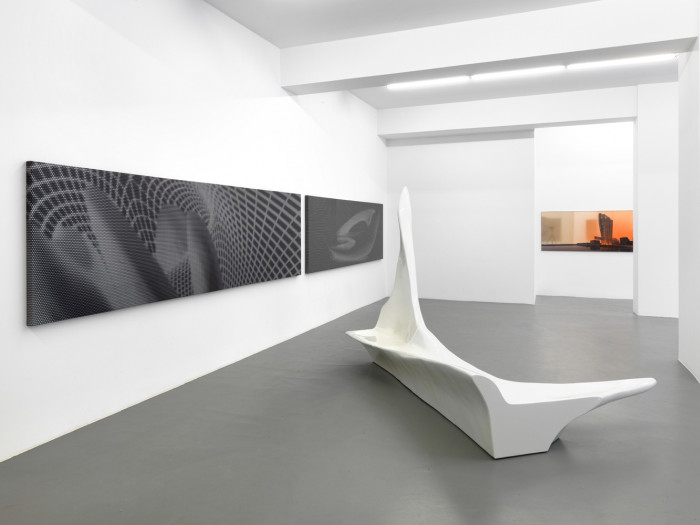Zaha Hadid
The Buchmann Galerie is pleased to announce its third exhibition with the architect Zaha Hadid (b. 1950 in Baghdad), to coincide with Gallery Weekend in Berlin.
The focus of the presentation is on eight Silver Paintings, three Dot Paintings, and the large furniture-sculpture Iceberg.
Zaha Hadid became internationally known in the early 1980s for a series of spectacular designs, drawings, and paintings, such as her prize-winning design The Peak Leisure Club, Hong Kong in 1983.
These early studies were unusual in that they were not simply studies associated with a task but also permitted an open interpretation of the project from various perspectives.
Architecture always exists in the area of tension between 2-D and 3-D, between the translation of drawing into building. Nevertheless, in architecture is it precisely the drawing, the 2-D works, that achieved true innovations, which is why the Silver Paintings and the Dot Paintings are particularly important in this exhibition. “Drawing accelerates the evolution of architecture,” as Patrik Schumacher, Senior Office Partner at ZHA Architects, explains. He continues: “My thesis here is that with the withdrawal into the two-dimensional surface, i. e. the refusal to interpret everything immediately as a spatial representation, is a condition for the full exploitation of the medium of drawing as a medium on invention. Only on this basis, as explicitly graphic manœvres, do the design maneuvers gain enough fluidity and freedom to play.” (Patrik Schumacher, MAK Wien, 2003, p. 22)
Zaha Hadid’s Silver Paintings and Dot Paintings thus express notions of space that are otherwise familiar only from abstract formulas or can only be experienced as tectonic forms. Images are important to the studio’s work because their modulations of color, gradients of dark to light or pointillist techniques are design means that cause objects to disappear against their background, showing different options on the long path to the built reality. The graphic forms of the Silver Paintings and Dot Paintings are translated step by step into tectonic structures.
Zaha Hadid’s images are representational without being naturalistic, because they do not show physical realities but rather architectural possibilities: Hadid’s vision of an abstract architecture whose formal language she has developed from her occupation with Suprematism.
Detlef Mertins explains in the catalog to Hadid’s 2006 exhibition at the Guggenheim Museum: “Hadid transformed Suprematism from an art of building complex structures out of elemental geometric shapes into one that seeks to make visible the elemental nature inherent in the world. Where Malevich declared in 1920 that the forms of Suprematism ‘have nothing in common with the technology of the earth’s surface,’ Zaha Hadid’s paintings bring mathematical and geological geometries into greater alignment.”
The Iceberg furniture piece, designed for Sawaya & Moroni, is part of a line of formal research that explores the idea of liquid territories. As well there is the Icestorm, a sculpture designed for the MAK in Vienna that embraces and incorporates these different furniture pieces within one whole liquid landscape. The Iceberg is a bench that enables the user to sit on both sides. The outstanding and apparent features of this bench are two icicles – like extensions. One is darting into horizontality whereas the other points vertical. Although these two shapes are opposing and contrasting each other there is mediation between them through a diagonal fold that “morphs” one shape into the other. The morphing process (the continuous transition from one shape to another) enables us to blend disparate shapes into one organic whole.
Zaha Hadid has consistently extended the limits of architecture and the designed space. Her experimentation with new spatial concepts has attracted worldwide attention and esteem. In a few weeks, one of Zaha Hadid’s latest projects, the Olympic Aquatic Centre in London will be opened to the public.
“There are 360 degrees, so why stick to one?” (Zaha Hadid)
For additional information on the artists or illustrations of her work, please feel free to contact the gallery at any time.
Zaha Hadid
Born 1950 Bagdad/ Iraq. Lives and works in London.
| 2007 | Ideal House, Internationale Möbelmesse, Köln |
| 2006 |
Tokyo Blossoms, The Haro Museum Installation, Tokio 25 Years of Deutsche Bank Collection, Singapore Art Museum, Singapur |
| 2005 |
Elastika intervention at Design 05, Art Basel, Miami Beach 25 Jahre Sammlung Deutsche Bank, Deutsche Guggenheim, Berlin |
| 2004 | Sulle Tracce di Mozart, Palazzo Reale, Mailand |
| 2000 | Borderline Exhibition, Palais des Beaux Arts, Brüssel |
| 1997 | Mind Zone, Millenium Dome, London |
| 1998 | Addressing the Century: 100 Years of Art and Fashion, Hayward Gallery, London |
| 1996 |
Wiener Kunsthalle, Wien Leopold-Hosch Museum, Düren |
| 1992 | Solomon R Guggenheim Museum, New York |






